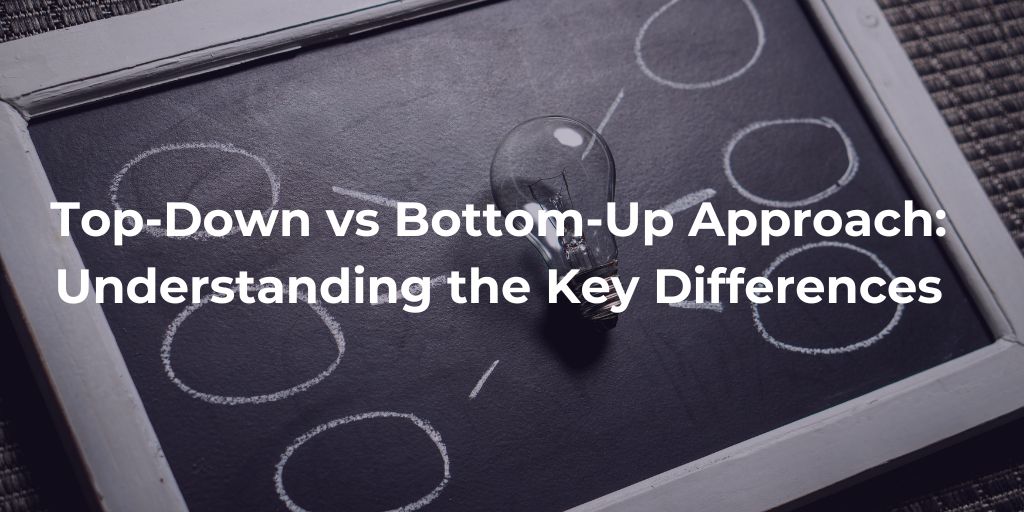Categories
Tags
Newsletter
Subscribe to the QRP International neswletter and get all the news on trends, useful contents and invitations to our upcoming events
Subscribe
In today’s fast-paced business environment, striving for maximum organisational efficiency is essential. Understanding different management styles, particularly top-down and bottom-up approaches, plays a key role. Each method brings unique advantages and challenges that can significantly impact a company’s performance and success.
A top-down approach can be a method or strategy used for problem-solving, frequently applicable to organisations, where the process begins at the highest conceptual level and progresses to the details. This approach often contrasts with the bottom-up approach, which starts from a more detailed-point-of-view and works upwards to form a comprehensive view or solution.
A bottom-up approach is a strategy used across various fields, including management, software development and project planning, where the process begins at the most detailed level and works upwards to form the bigger picture or solution.
The top-down approach to management is a strategy in which the decision-making process occurs at the highest level before communicating to the rest of the team. This management style can be applied at the project, team, or even the company level, and can be adjusted according to the particular group’s needs.
Key elements of top-down management:
Certain experts claim that the top-down approach is no longer used in the modern working environment. Top management should not be trying to lead projects or change initiatives directly but involve their employees from the beginning to make decisions.
Below a list of benefits and advantages of top-down management:
Bottom-up management implies that goals, projects, and processes are defined largely by employee feedback. Employees are involved in goal setting – sometimes simply with feedback or by being involved in decisions. The outcome is then communicated by each team to senior management.
Key elements of bottom-up management:
Bottom-up management can solve many of the problems that come with a top-down approach. Bottom-up management has advantages that make it a great fit for creative teams and industries where collaboration is key, like software development or product design.
Below a list of benefits and advantages of bottom-up management:
While a bottom-up approach allows decisions to be made by the same people who are working directly on a project, the top-down style of management creates distance between that team and decision-makers. This can lead to poorly-informed decisions if leadership doesn’t ask for input or feedback from their project team.
Below a list of key differences between top-down and bottom-up management:
| Aspect | Top-Down Management | Bottom-Up Management |
|---|---|---|
| Decision Making | Decisions are made by senior management | Decisions are made at all levels |
| Control | High degree of control from the top | Decentralised control with autonomous teams |
| Communication | Top-down | Among all levels |
| Innovation | Aligned with organisational goals | More experimental and diverse |
| Employee Role | Clearly defined roles and responsibilities | Cross-functional opportunities |
| Problem-Solving | Senior management | Employees closest to the issue |
| Feedback | Formal and scarce | Informal and continuous |
| Adaptability | Top-directed and slower | Quicker to adapt |
| Engagement | Employee engagement can be lower | Higher: active participation and empowerment |
When choosing which management style to go with for your organisation, you will have to look at your business objectives, organisational culture, industry, and specific team dynamics. The needs of companies and employees are constantly shifting, therefore organisations should be able to adapt both the top-down and bottom-up approaches. Training your management and employees to effectively apply both of these approaches will make it easier to transition between them as different needs arise.
Whether your team uses a top-down or bottom-up approach, fostering collaboration between teams that don’t normally work together can generate big benefits. Cross-team collaboration can help stimulate creativity, build relationships, and lead to out-of-the-box solutions that can later be implemented to benefit the greater group.
When it comes down to great management, leaders within the organisation should know how to balance the efficiency of the top-down approach with the collaborative and creative advantages that come from the entire team. By blending elements of different management styles, you can find an approach that works best for you and your unique team. Once you decide the right approach, you can understand how to best train your employees to achieve the right skill set.
Would you like to learn more about our Project Management Courses? QRP International is an Accredited Training Organisation (ATO). We can support you with PRINCE2, PM2, PMP, AgilePM or PRINCE2 Agile. Contact us for more information!